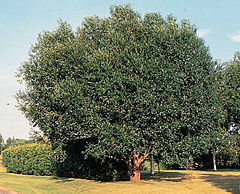Bay Willow: Difference between revisions
No edit summary |
No edit summary |
||
| (4 intermediate revisions by 2 users not shown) | |||
| Line 1: | Line 1: | ||
{{ | {{SPlantbox | ||
| | |familia=Salicaceae | ||
| | |genus=Salix | ||
| | |species=pentandra | ||
|taxo_author=L. | |||
|common_name=Bay willow, Laurel willow | |||
|name_ref=Flora - A Gardener's Encyclopedia | |||
|habit=tree | |||
|habit_ref=Flora - A Gardener's Encyclopedia | |||
|Max ht box=50 | |||
|Max ht metric=ft | |||
|height_ref=Flora - A Gardener's Encyclopedia | |||
|Max wd box=30 | |||
|Max wd metric=ft | |||
|width_ref=Flora - A Gardener's Encyclopedia | |||
|lifespan=perennial | |||
|life_ref=Flora - A Gardener's Encyclopedia | |||
|exposure=sun | |||
|sun_ref=Flora - A Gardener's Encyclopedia | |||
|water=wet, moist | |||
|water_ref=Sunset National Garden Book | |||
|features=flowers | |||
|flower_season=early spring, mid spring, late spring | |||
|flower_ref=Flora - A Gardener's Encyclopedia | |||
|flowers=orange, yellow | |||
|Temp Metric=°F | |||
|min_zone=5 | |||
|usda_ref=Flora - A Gardener's Encyclopedia | |||
|max_zone=10 | |||
|image=Salix pentandra(01).jpg | |||
|image_width=240 | |||
|image_caption=Bay Willow with early autumn colours | |||
}} | |||
'''''Salix pentandra''''' ('''Bay Willow''') is a species of [[willow]] native to northern [[Europe]] and northern [[Asia]].<ref name=rushforth>Rushforth, K. (1999). ''Trees of Britain and Europe''. Collins ISBN 0-00-220013-9.</ref> | |||
It is a large [[shrub]] or small [[tree]] growing to 14 m tall (rarely to 17 m), usually growing in wet, boggy ground. The [[Leaf|leaves]] are glossy dark green, 5-12 cm long and 2-5 cm broad, with a finely serrated margin. The [[plant sexuality|dioecious]] [[flower]]s are [[catkin]]s, produced in late spring after the leaves; the male catkins are yellow, 2-5 cm long, the female catkins greenish, 1.5-3 cm long; they are pollinated by bees. The [[fruit]] is a small [[capsule (fruit)|capsule]] containing numerous minute [[seed]]s embedded in white down which aids wind dispersal.<ref name=rushforth/><ref name=afm>Mitchell, A. F. (1974). ''A Field Guide to the Trees of Britain and Northern Europe''. Collins ISBN 0-00-212035-6</ref> | |||
The scientific name refers to the male flowers having five stamens. The English name derives from the resemblance of the leaves to those of the [[Bay Laurel]]; other common names include '''Bay-leaved Willow''' and '''Laurel Willow'''. Its glossy leaves make it more decorative than many other willows, and it is often planted as an [[ornamental tree]].<ref name=rushforth/> | |||
It has become locally [[naturalisation (biology)|naturalised]] in northern [[North America]], and is widely known as '''Laurel Leaf Willow''' there. | |||
{{Inc| | |||
'''''[[Salix]] pentandra'''''. (S. laurifolia, Hort. S.Humboldtiana, Hort. not Willd.). Bay-leaf or Laurel-leaf Willow. Shrub or small tree, 8-20 ft. high: branches chestnut-color: lvs. large, elliptic to broadly oblanceolate, acuminate, shining and dark green above, paler beneath: aments appearing after many of the lvs. are fully developed, not conspicuous. Eu. and Asia. | |||
| | |||
| | |||
}} | }} | ||
==Cultivation== | |||
===Propagation=== | |||
===Pests and diseases=== | |||
==Varieties== | |||
==Gallery== | |||
<gallery perrow=5> | |||
File:Pod lipskiem liście krzewu do ident. 17.07.09 pl6.jpg | |||
Image:Upload.png| photo 1 | |||
Image:Upload.png| photo 2 | |||
Image:Upload.png| photo 3 | |||
</gallery> | |||
[[ | ==References== | ||
The | <references/> | ||
*[[Standard Cyclopedia of Horticulture]], by L. H. Bailey, MacMillan Co., 1963 | |||
<!--- xxxxx *Flora: The Gardener's Bible, by Sean Hogan. Global Book Publishing, 2003. ISBN 0881925381 --> | |||
<!--- xxxxx *American Horticultural Society: A-Z Encyclopedia of Garden Plants, by Christopher Brickell, Judith D. Zuk. 1996. ISBN 0789419432 --> | |||
<!--- xxxxx *Sunset National Garden Book. Sunset Books, Inc., 1997. ISBN 0376038608 --> | |||
{{ | ==External links== | ||
*{{wplink}} | |||
{{stub}} | |||
__NOTOC__ | |||
Latest revision as of 18:22, 7 May 2010
| Salix pentandra subsp. var. | Bay willow, Laurel willow | |||||||||||||||||||||||||||||||||||||||||||||||||||||||
|---|---|---|---|---|---|---|---|---|---|---|---|---|---|---|---|---|---|---|---|---|---|---|---|---|---|---|---|---|---|---|---|---|---|---|---|---|---|---|---|---|---|---|---|---|---|---|---|---|---|---|---|---|---|---|---|---|

|
|
| ||||||||||||||||||||||||||||||||||||||||||||||||||||||
| ||||||||||||||||||||||||||||||||||||||||||||||||||||||||
Salix pentandra (Bay Willow) is a species of willow native to northern Europe and northern Asia.[1]
It is a large shrub or small tree growing to 14 m tall (rarely to 17 m), usually growing in wet, boggy ground. The leaves are glossy dark green, 5-12 cm long and 2-5 cm broad, with a finely serrated margin. The dioecious flowers are catkins, produced in late spring after the leaves; the male catkins are yellow, 2-5 cm long, the female catkins greenish, 1.5-3 cm long; they are pollinated by bees. The fruit is a small capsule containing numerous minute seeds embedded in white down which aids wind dispersal.[1][2]
The scientific name refers to the male flowers having five stamens. The English name derives from the resemblance of the leaves to those of the Bay Laurel; other common names include Bay-leaved Willow and Laurel Willow. Its glossy leaves make it more decorative than many other willows, and it is often planted as an ornamental tree.[1]
It has become locally naturalised in northern North America, and is widely known as Laurel Leaf Willow there.
| Standard Cyclopedia of Horticulture |
|---|
|
Salix pentandra. (S. laurifolia, Hort. S.Humboldtiana, Hort. not Willd.). Bay-leaf or Laurel-leaf Willow. Shrub or small tree, 8-20 ft. high: branches chestnut-color: lvs. large, elliptic to broadly oblanceolate, acuminate, shining and dark green above, paler beneath: aments appearing after many of the lvs. are fully developed, not conspicuous. Eu. and Asia.
|
Cultivation
Propagation
Pests and diseases
Varieties
Gallery
-
photo 1
-
photo 2
-
photo 3
References
- Standard Cyclopedia of Horticulture, by L. H. Bailey, MacMillan Co., 1963
External links
- w:Bay Willow. Some of the material on this page may be from Wikipedia, under the Creative Commons license.
- Bay Willow QR Code (Size 50, 100, 200, 500)

